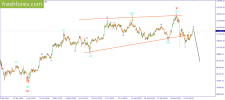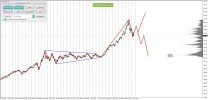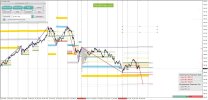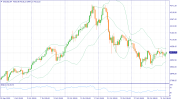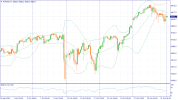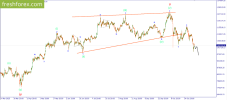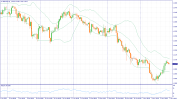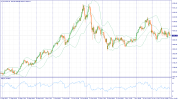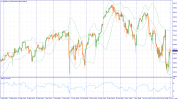Weekly Outlook: XAUUSD, #SP500, #BRENT
XAUUSD: BUY 4065.00, SL 4035.00, TP 4335.00
For our readers only — a 202% bonus on deposits from $202; quote promo code WINх2 to customer support and trade with TRIPLED capital. See the link for details.

Gold enters the new week having corrected from recent all-time highs: the spot price is fluctuating around $4,070 per ounce after a series of sessions above $4,200.
The weakening of quotes is due to a partial withdrawal of demand for safe-haven assets after the end of the record 43-day U.S. government shutdown and stricter comments from some Federal Reserve officials, which, in the market’s view, reduced the probability of a December rate cut.
Nevertheless, gold remains close to its yearly highs: investors are pricing in the next cycle of Fed policy easing against the backdrop of persistent structural risks in the U.S. economy and uneven growth in China and Europe.
An important fundamental argument in favor of gold is the signs of cooling in the U.S. economy. The University of Michigan consumer sentiment index has fallen towards multi-year lows, and corporate layoff statistics show a sharp jump in staff reductions, which amplifies concerns about the labor market.
At the same time, because of the recent government shutdown, key reports on employment and inflation were released with a delay or may not be published at all, leaving the Fed in conditions of “limited visibility” and increasing markets’ sensitivity to any hints of slowing growth. In this environment, gold retains its status as an insurance instrument against a possible deterioration of the macro picture and additional declines in the real yields of U.S. Treasuries.
On a one-week horizon, the baseline scenario assumes that the correction from the peaks will remain moderate: although the market consensus on a December Fed rate cut has been revised down, investors still expect further policy easing in 2025 and, along with it, a gradual weakening of the dollar and support for precious metals.
At the same time, some analysts still view the current phase as a pause before a new wave of growth in gold prices amid persistent geopolitical and fiscal risks. The scenario for speculative purchases looks like “buying moderate pullbacks” with a focus on the area above $4,300, while maintaining risk control through a stop order below the important psychological level of $4,035 per ounce.
Trading recommendation: BUY 4065.00, SL 4035.00, TP 4335.00
#SP500: BUY 6720, SL 6660, TP 7080

The S&P 500 index ended last week near 6,734 points, having corrected from renewed highs amid a sell-off in technology stocks and a reassessment of expectations for the Fed’s rate path.
After strong growth in recent months, the market has faced a combination of factors: expensive company valuations, rising investor caution ahead of a block of earnings reports from leading issuers (including Nvidia), and uncertainty about the further pace of rate cuts. The weekly review of the U.S. stock market for 17–21 November notes that the consensus on the S&P 500 remains “moderately positive”, but the forecast is accompanied by an emphasis on increased volatility and the index’s sensitivity to news from the technology sector and U.S. statistics.
The fundamental backdrop for the index is mixed. On the one hand, the third-quarter earnings season was better than expected: about 92% of companies have already reported, and roughly 82% beat earnings forecasts, which supports the view of resilient corporate profits and provides arguments in favor of keeping exposure to equities.
On the other hand, the prolonged U.S. government shutdown led to delays in the publication of key macro data, and now the market has to digest several reports on employment, inflation, and GDP in a compressed timeframe. The Fed has already cut the rate to a 3.75–4.00% range, but some members of the regulator suggest acting more cautiously until the full flow of statistics is restored, which reduces the likelihood of another easing step in the near term.
Over the coming week, the key drivers for #SP500 will be the release of the minutes from the latest Fed meeting, preliminary U.S. PMI data, and earnings from the largest high-tech companies. If the data do not point to a sharp deterioration in economic activity and the Fed minutes confirm its readiness to maintain a soft stance if needed, investors may see the recent correction as an opportunity to resume buying in the index, relying on strong corporate results. At the same time, there remains a risk of a further wave of profit-taking if Nvidia’s results and those of other growth leaders disappoint, or if the regulator’s rhetoric again shifts toward a more restrictive approach.
Trading recommendation: BUY 6720, SL 6660, TP 7080
#BRENT: SELL 64.00, SL 65.00, TP 55.00

Brent starts the week around $63.8 per barrel: after volatile moves in the first half of November, prices are consolidating near the lows of the month.
Pressure on the market has intensified after the publication of reports by OPEC and the International Energy Agency: according to IEA estimates, by 2026 the global oil market could face a surplus of up to 4.09 million barrels per day — about 4% of global demand.
Rising production in both OPEC+ countries and competitors (the U.S., Brazil, and others), combined with moderate consumption growth, is leading to stock build-ups: the volume of global oil reserves has already risen to its highest level since 2021, including due to the increase in “floating” inventories on tankers.
In the short term, the situation was aggravated by OPEC+ revising its forecast toward an oversupplied market, which, according to analysts, became the trigger for an aggressive sell-off in futures and a drop in Brent to the $62–63 area.
Some experts allow for a further decline in prices toward $57–58 per barrel, emphasizing that the main risk for prices now is not so much cartel decisions as the steady growth of U.S. production, which can offset any restrictive measures by OPEC+. At the same time, the market is under pressure from U.S. Department of Energy data showing a noticeable increase in commercial crude inventories, while fuel demand is growing weakly, making it possible for the period of “soft” oil prices to be extended through 2026.
On a one-week horizon, the fundamental balance for #BRENT is tilted toward a moderately bearish scenario: the expected slowdown in the global economy, the risk of oversupply, and rising stocks limit the potential for a sustainable upward reversal, while local spikes driven by geopolitics or sanctions look more like opportunities for short-term profit-taking than the start of a new long-term uptrend.
In this configuration, the basic approach is to consider selling when prices approach the $64–65 per barrel area, aiming for a gradual shift of quotes below $60, taking into account scenarios in which Brent could move toward $57–58 if the signal of a surplus market strengthens further. A stop above $65 per barrel protects against the scenario of a sharp short-term spike in prices in the event of supply disruptions.
Trading recommendation: SELL 64.00, SL 65.00, TP 55.00
